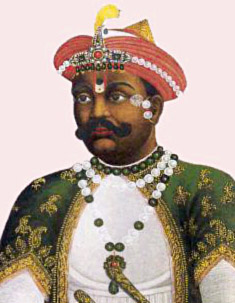 Mahadji Scindia was an outstanding personality among the Marathas. He was born in the year 1727 and had expired in 1794. The life of Mahadji Scindia was a long period of strenuous activity. Up to 1761, he was an obscure figure overshadowed by his brilliant brothers. From 1761 to 1772, his life was one of apprenticeship in which he acquired the supreme fitness which later on helped him to co-operate with Nana Fadnavis to defeat the British during the First Anglo Maratha War. After that, he gained valuable experience of war and diplomacy on his own initiative which he put in actual test later on. Towards the end he created a kingdom of his own.
Mahadji Scindia was an outstanding personality among the Marathas. He was born in the year 1727 and had expired in 1794. The life of Mahadji Scindia was a long period of strenuous activity. Up to 1761, he was an obscure figure overshadowed by his brilliant brothers. From 1761 to 1772, his life was one of apprenticeship in which he acquired the supreme fitness which later on helped him to co-operate with Nana Fadnavis to defeat the British during the First Anglo Maratha War. After that, he gained valuable experience of war and diplomacy on his own initiative which he put in actual test later on. Towards the end he created a kingdom of his own.
The private life of Mahadji was pure and free from blemish. He was free from caste and religious bias. He was equally respected by the Hindus and the Muslims. He employed the Brahamans, the Prabhus, the Marathas and the Mahars. The Saraswat Brahmans attained special distinction in his service and diplomats. He was always careful and faithful to the Peshwa family. He never tried to assert his independence.
Mahadji Scindia was a heroic personality and he dominated the North Indian history of his time like a colossus. His resources were defective. His instruments and allies often played him false and he had to face many anxious crises.
Mahadji Scindia had become the Regent of the Empire Delhi and got the titles of Wakil-i-Mutlak, Bakshi-ul-Mamalik, Amir-ul-Umra and Alija. There were many around him who were jealous of his position and prayed for his downfall. It has been recorded in history that Mahadji Scindia bore with patience all the criticism that was bestowed upon him.
Mahadji Scindia towers over Maratha history in solitary grandeur. He was a ruler of India who did not have any allies or a party. With the death of Mahadji Scindia the Marathas lost one of their best warriors and their most foreseeing statesman. In his life Mahadji Scindia had two main objectives, one to find a kingdom and the other to prepare for the contest for Empire with the British. It can be said that in both his objectives he succeeded.



















